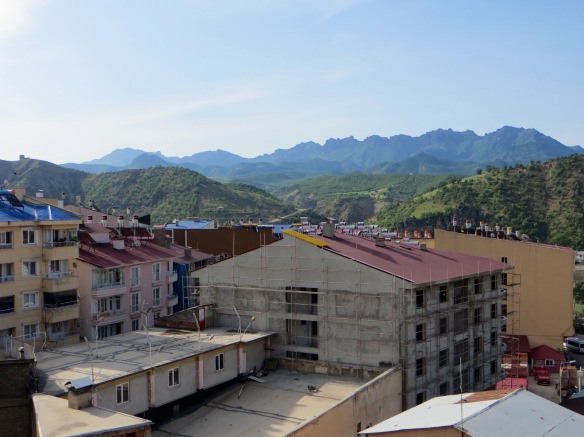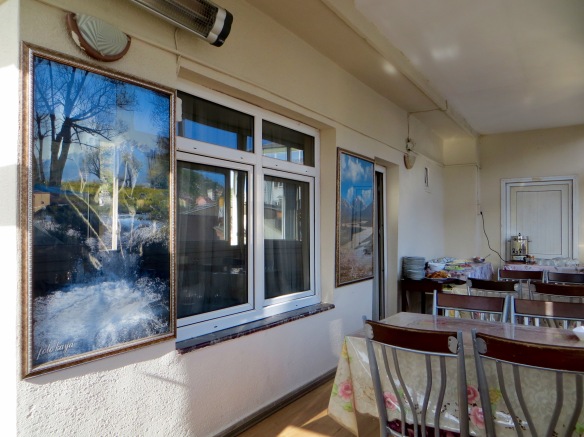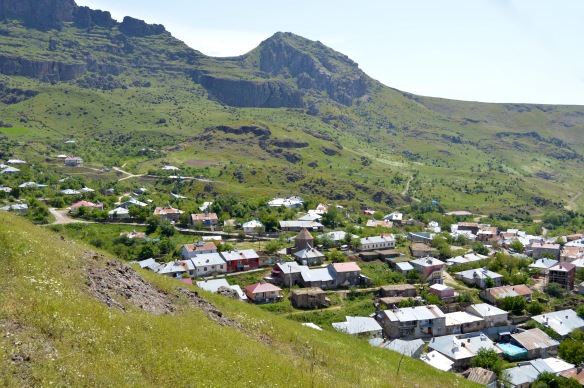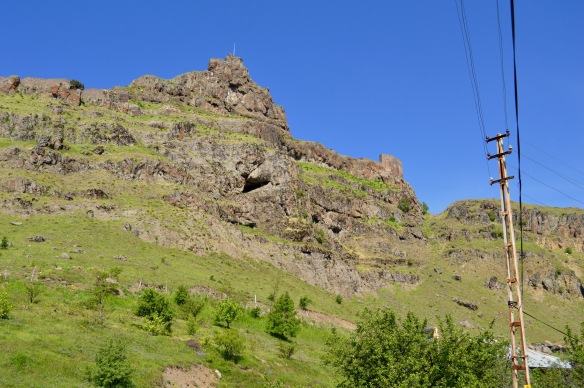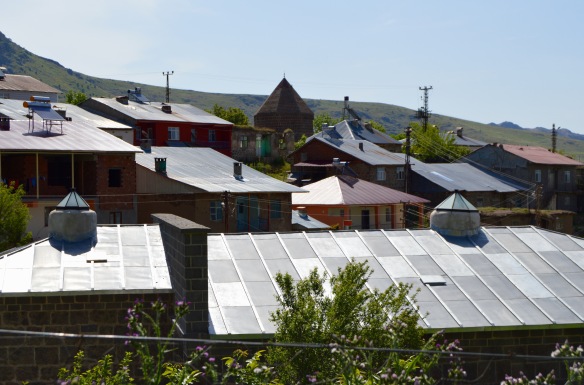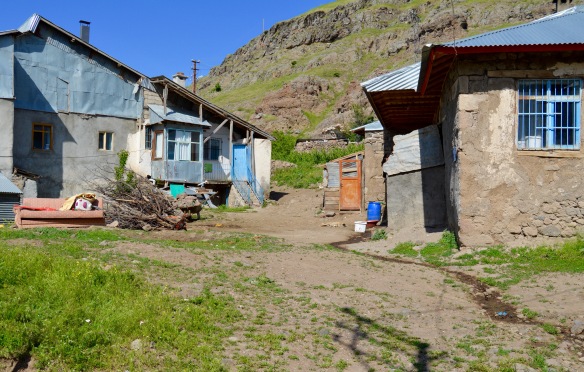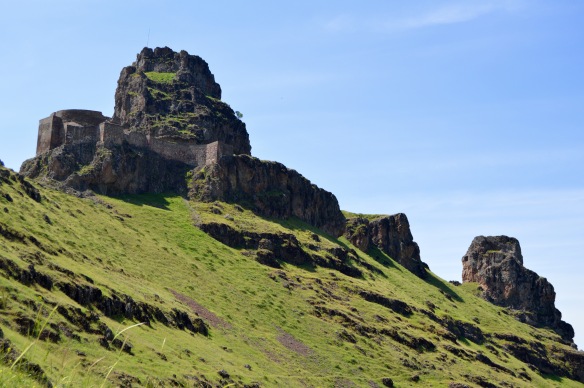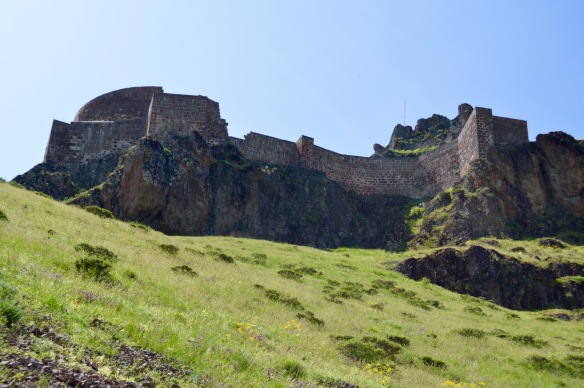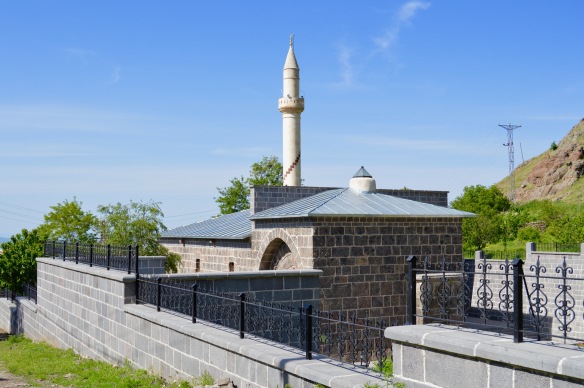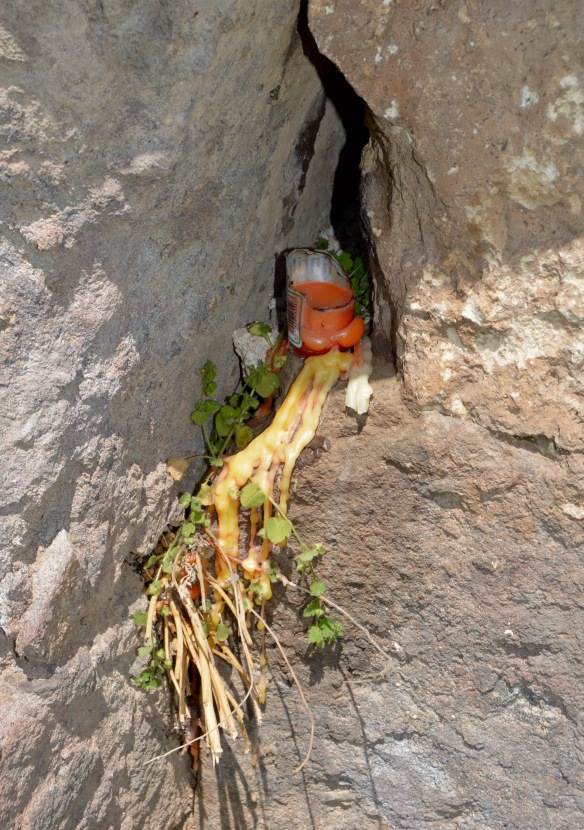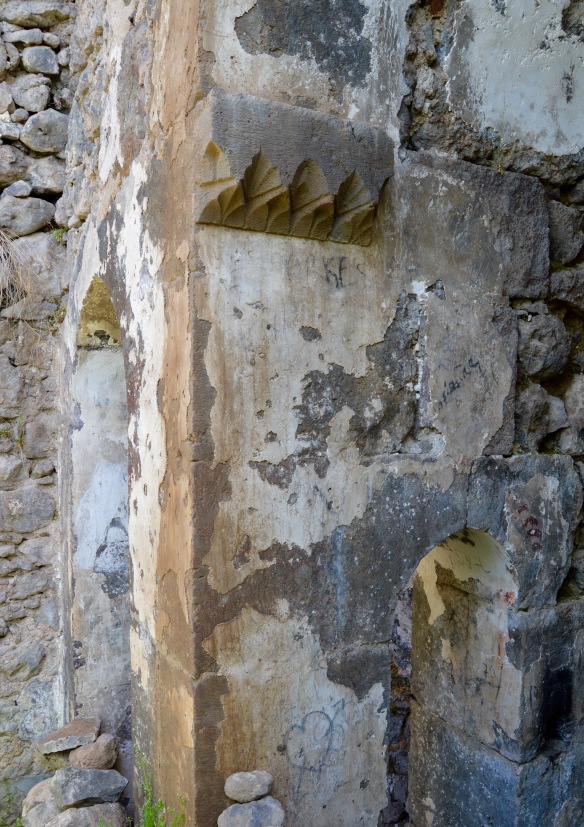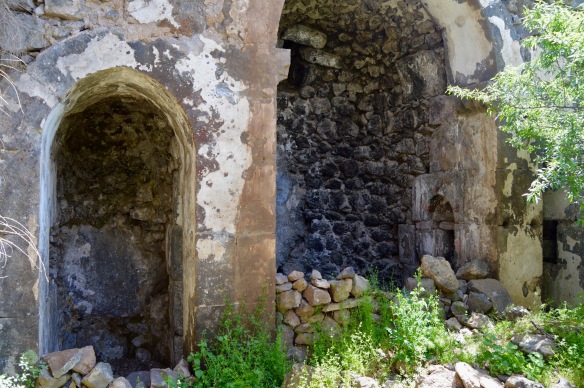I was back at the hotel by 1.00pm and washed a few items of clothing before sitting on the balcony to write some notes about the morning. I felt a little tired, perhaps because of being in the sun for a long time and walking to and from Mazgirt’s citadel, but when I had some honey and yoghurt with the last of a simit from Tamdere, the fatigue evaporated. I decided to have one last adventure to the village of Cicekli south of Tunceli. On the way to Mazgirt, I had passed the road junction for Cicekli and, because the name of the village contained the Turkish word for flower or blossom (“cicek”), I was curious to see what it looked like.
With cloud building up in the sky, I walked to the road bridge over the river and flagged a minibus to the university. I got off at the campus entrance and started walking south. When a heavy rainstorm began, I sheltered under trees overhanging the fence surrounding the garden of a large modern house. When the worst of the rain had eased, I tried flagging a lift to the road junction for Cicekli, but had no luck. The junction was further from the campus than I remembered, but I eventually got to it and began to ascend quite steadily but gently into the hills. Cicekli lay 9 kilometres away, but the undulating hill country through which I walked was very attractive. Every so often there were excellent views of the large campus, which was now below me. Not all the university’s buildings were complete, but the ones that were looked enviably attractive, albeit in an institutional manner, which confirmed that generous amounts of money were being directed toward higher education, even in a province such as Dersim so often starved of resources in the past. In the distance were the mountains through which I had travelled the day before to Ovacik, but nearby were fields, pasture, wild flowers, patches of woodland and isolated farms and houses.
The road led to more villages than Cicekli alone, but traffic was very light. However, an elderly man, a retired guestworker who had spent most of his life in Germany, eventually stopped his car and made a short detour to drop me in the middle of Cicekli. Just before entering the village, we passed a very large rectangular jandarma post with high walls, towers at each corner, a fortified entrance, lots of razor wire, large dogs and many armed jandarma who closely scrutinised the infrequent movements on the nearby road. The occupied jandarma post confirmed that worries about security remained in Dersim, but why in an area with a relatively small population was a mystery to me. Given the substantial presence of uniformed representatives of the state in Tunceli, the armoured vehicles parked in the town’s streets and what I now saw, Dersim suddenly felt like occupied territory controlled by a colonial power. If this feeling afflicted me and I had been in the locality less than 36 hours, how must the local people feel, be they Turks, Kurds, Armenians, Alevis or Kizilbash?
Cicekli did not have any more flowers than was typical of rural Dersim, but the mixture of old and new housing, and the friendliness of the people with whom I spoke, meant I had chosen a suitable destination for the latter half of the day. The sky remained overcast, which meant it was pleasantly cool as I walked around.
Cicekli was not a large village and did not support a tea house or a shop. The buildings were dispersed over a gently inclined hillside overlooking a pretty valley wider than many in the area. Small fields, pasture and orchards surrounded the buildings. Most families earned a living from the land and a lot of buildings were therefore used for agricultural purposes. Many of the old buildings, some of which spread over two storeys, had been constructed with a very attractive stone, no doubt quarried locally, which, although dominated by a light brown colour, also had white and orange smudges. Some of the barns and other buildings used for storage purposes utilised corrugated iron and flat metal sheets to good effect, and a few brightly coloured trailers and motor vehicles added visual interest. Many of the old houses were quite large, which suggested that the village used to be wealthy by local standards.
The road to Cicekli had carried very little traffic on it, so, after about an hour in the village, I left for Tunceli concerned about how long it would take to get back to town. As I walked beside the jandarma post a few of the jandarma waved, but their large dogs barked in a very threatening manner. Two women stood in pasture about 100 metres from the road; they were responsible for a small herd of cattle. I walked beside a gulley where, despite the attractive surroundings in which it lay, people had tipped large amounts of litter. Two cars drove by, but the drivers ignored my requests for a lift. However, after walking about 3 kilometres, a car stopped and the driver took me all the way to the main Tunceli to Elazig road. He explained that he lived in a village about 15 kilometres to the north and west of Cicekli, which made me realise that the local road network was more extensive than I had imagined (and the local road network had no doubt improved significantly in recent years, primarily to make it easier for the police, the jandarma and/or the army to move around more rapidly).
I began walking toward Tunceli once I was on the main road, but a minibus serving the university and the first settlement to the south of it offered me a lift to the campus, which gave me the chance to confirm that the university’s buildings had been designed and built in ways that could not fail to inspire admiration. My short time on the campus confirmed what I had observed the day before, that only a small number of female students wore headscarves.
I was ushered onto a second minibus, but, instead of going to Tunceli, it was driven south toward Elazig to drop off two members of staff at a small settlement beside the river (the river was very wide near the settlement due to a dam lower down its course), then it returned to the campus! I was now taken to the point from where minibuses departed for Tunceli and, with every seat but mine occupied by students, we soon left for our destination. Kindly, I had been given the best seat on the minibus, the one next the driver, so the views were excellent. Despite all my worries about getting back to Tunceli in good time, I was in the town centre not long after 5.00pm.
I had a good look around the small pazar where all the businesses were open and many benefitted from people shopping at the end of the working day. I also noticed that it was from the edge of the pazar where minibuses left for my next destination, Pertek, so I confirmed with the staff in a small office about departures early the following morning.
I sorted a few things in my room, then walked to the river intent on having a good meal in a pleasant lokanta, preferably one that served beer overlooking the river (I could hardly go without alcohol in Tunceli on my last night, given how many local places sold it). Almost facing each other across the river were two large lokantas and between them a footbridge made it easier to examine both.
I decided to eat in Celal Dogan Restaurant on the side of the river closest to the town centre, partly because it was still in the early evening sunshine, and partly because it had many more customers (although young women seemed to prefer the relative quiet of the lokanta furthest from the town centre and now completely in the shade). I could have eaten indoors, but a table was free beside the river where fish rise to the surface to catch insects and birds feed on the wing. Although offered a menu as I sat down, I knew exactly what I wanted from a list of food displayed on a large board in the small car park: a lamb sac kavurma, a dish I had grown to love in recent years, and one that Alevis in Dersim claimed as their own. I ordered a Tuborg and, about 15 minutes later, a sublime melt-in-the-mouth sac kavurma arrived with a basket containing warm flat-bread similar to lavash. Just for the record, the sac kavurma comprised of very tender, perfectly fried cubes of lamb, a generous portion of bulgar pilaf and an equally generous amount of onions, peppers and tomatoes fried together so the flavours of the individual ingredients exchanged with each other to good effect. Sliced raw onion decorated the top of the food to provide a contrast in taste and texture.
At the end of the meal, I chatted with a young man from Mazgirt who was aged about 17 and training to be a waiter. After handing over 27TL for the meal (the sum of money included a generous tip for the high quality of the food and service), I walked through the park to the town centre, once again encountering many snails on the footpath. Cloud was building up again and the dull and humid conditions had tempted the snails to search for food.
Snails on the move seeking food. I was suddenly reminded that Hilary and Pippa were leaving the next day for a city break in Amsterdam and our garden would be left unattended for five whole days. Would the peas, beans, tomatoes, lettuce, basil and sage survive? Kindly, our next door neighbours had said they would water the plants if a dry spell prevailed.
I bought a second beer in the pazar and retired to my balcony from where I watched the night descend. The streets below remained very lively, but a few large drops of rain began to fall and thunder rumbled in the distance. Lightning, sometimes in forks and sometimes in sheets, filled the sky to the south and southwest, and the rain got steadily heavier. By 9.15pm, the rain was so persistent that the streets were almost deserted, many businesses had closed and only a few men sat at low tables outside two nearby tea houses playing cards. By 10.00pm, all the nearby businesses had shut and even the stray dogs sought shelter under roofs in the pazar. I had the last of the yoghurt, which, like the honey, had been locally made. I went to bed knowing Tunceli in particular and Dersim more generally had found a special place in my heart. Although I was leaving Tunceli the following morning, Pertek, where I was staying for two nights, was in Dersim, so I still had lots to enjoy.














